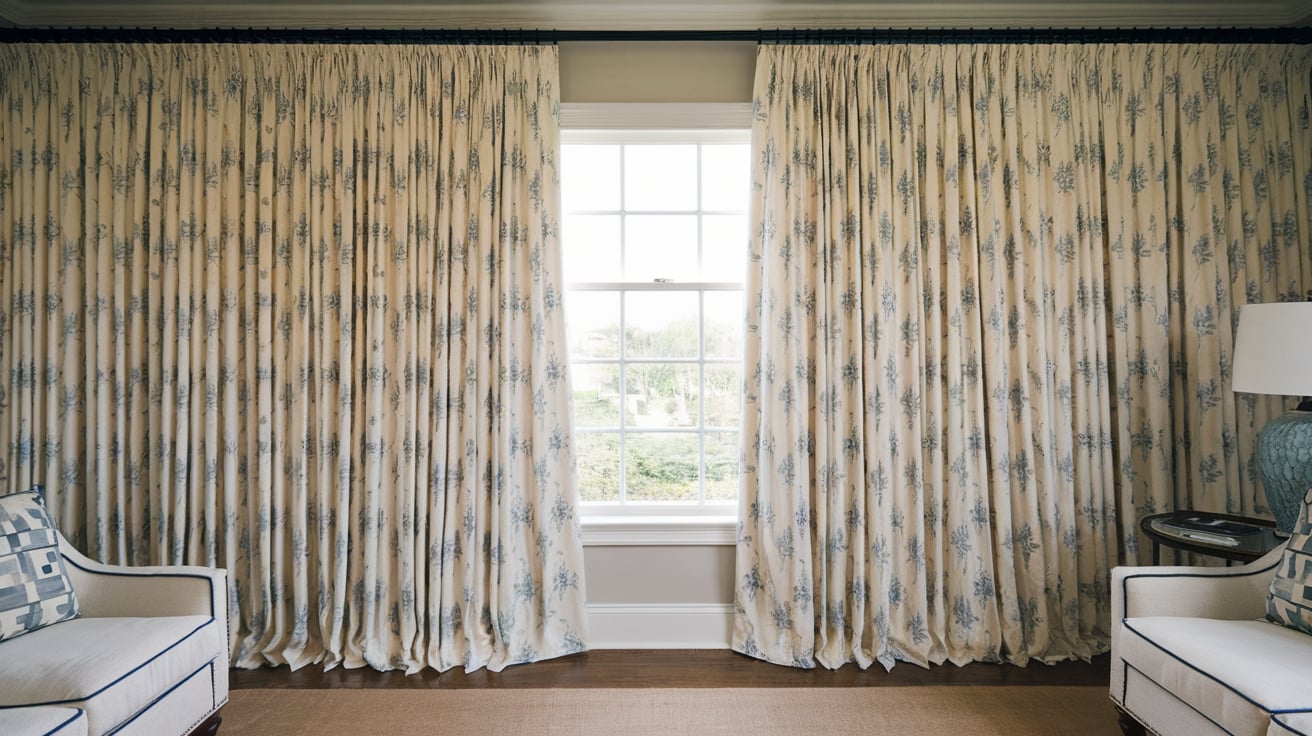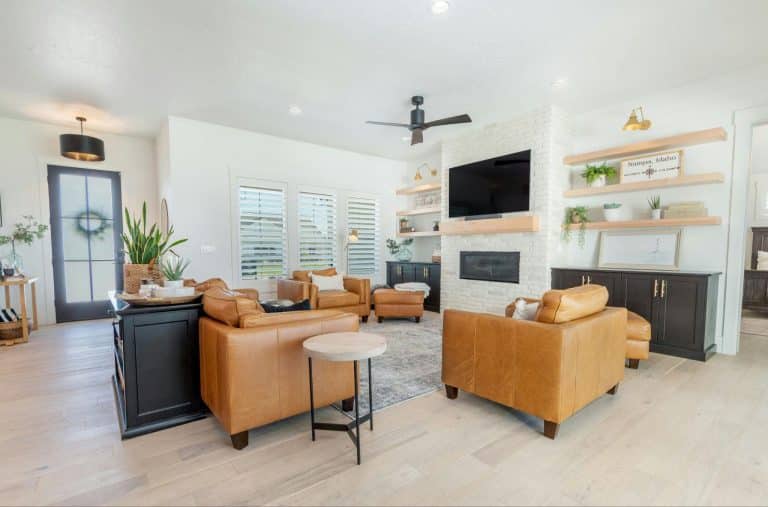Typical Curtain Lengths: A Guide to Choosing the Right Fit
Trying to find curtains that perfectly match your windows can feel like solving a puzzle. Many homeowners have panels that look too short or drag on the floor.
Most people don’t know that curtain lengths follow specific standards that match different window styles and room designs.
Getting these measurements right can change your space completely.
The right curtain length adds polish to your room, makes your windows appear larger, and creates the perfect blend of style and function.
When you understand the basics of curtain measurements, you’ll never second-guess your choices again.
Read on to learn the standard curtain lengths, how to measure your windows correctly, and tips for choosing the perfect fit for every room in your home.
Standard Curtain Lengths
Window treatments come in five standard lengths, each serving a specific purpose and room style. Understanding these sizes can help you make the right choice for your home.
1. 63-Inch Curtains
The shortest standard option works perfectly in kitchens, bathrooms, or rooms where you need shorter window coverings.
They stop at the window sill or fall just below it, which keeps them safe from water splashes near sinks or moisture in bathrooms. These shorter panels also work well under counters or furniture placed beneath windows.
2. 84-Inch Curtains
These panels rank as the most common choice for homes. They suit standard 8-foot ceilings perfectly.
When hung just above the window frame, they create a neat line that touches the floor without bunching. This length offers a tidy, structured look that fits most living rooms and bedrooms.
3. 96-Inch Curtains
These panels open up more hanging options. You can mount them higher above your window frame, which creates an illusion of taller windows.
In rooms with 9-foot ceilings, these curtains provide enough length to reach the floor while allowing for the above-window placement of the rod.
4. 108-Inch Curtains
For larger spaces, these panels meet the needs of rooms with higher ceilings. They give you the freedom to hang curtains well above the window frame.
They also allow for a slight break at the floor, where the fabric makes a small, graceful fold. This style adds a casual yet put-together feel to your room.
5. 120-Inch Curtains
The longest standard size serves spaces with high ceilings. These panels work well when you want to create a more formal setting.
You can hang them extra high to draw the eye upward or let them rest slightly on the floor for added luxury. This length fits perfectly in formal dining rooms or master bedrooms where you want to make a statement.
How to Choose the Right Curtain Length
The perfect curtain length starts with careful planning and measurement. Let’s break down the key steps to help you select the ideal length for your windows.
1. Measuring for Accuracy
Precise measurements form the foundation of well-fitted curtains. Begin with a metal measuring tape, as it provides the most accurate results.
Measure the complete width of your window, making sure to include the frame. Note the height from the window’s top point to where you want the curtains to end.
For proper rod placement, plan to add 4-6 inches of space on each side of the window. The rod should sit 3-4 inches above the window frame. This extra space allows your curtains to open fully and lets in more light when needed.
2. Window Height Considerations
Your window’s height plays a key role in length selection. Standard windows pair well with 84-inch panels, creating a clean line to the floor.
Taller windows call for 96-inch or 108-inch curtains to ensure full coverage. Shorter windows match nicely with 63-inch lengths.
For a crisp look, keep a half-inch space between the floor and curtain hem. If you prefer a softer style, add 1-2 inches extra to create a gentle break where the fabric meets the floor.
3. Room Style Impact
Each room has unique needs when it comes to curtain length. Living room curtains often work best when they reach the floor, adding a finished touch to the space.
Kitchen curtains should stay shorter, often at sill length, to keep them clean and functional.
Bedroom curtain length depends on your personal style and needs. Bathroom windows need shorter panels to stay dry and clean. Dining rooms benefit from floor-length curtains that add structure to the space.
4. Furniture Placement
Check your room’s layout before deciding on curtain length. Look for radiators or heating vents that might affect how your curtains hang.
Consider any furniture placed under or near windows that could interfere with longer panels. Window seats need special attention when measuring curtain length.
Remember to factor in your baseboards when taking measurements. If you have air conditioning units near windows, plan your curtain length to avoid blocking airflow.
Curtain Styles and Their Length Preferences
Different curtain styles need different lengths to achieve their intended look. Here’s what you need to know about each style:
1. Sill-Length Curtains
These curtains stop right at the window sill. Perfect for spaces that need practical window coverings, sill-length panels work well in busy areas. You’ll often find them in kitchens where they stay clear of countertops and sinks.
They also suit bathrooms, keeping the fabric away from water and moisture. This style measures about 63 inches long, making them easy to clean and maintain.
2. Apron-Length Curtains
Falling just below the window apron (the trim beneath your window), these curtains end about 4 inches below the window sill. This style offers a modern take on window coverings.
They work well in informal spaces and rooms where you want a clean, structured look. The length keeps curtains from touching the floor while still offering complete window coverage.
3. Floor-Length Curtains
These panels reach down to touch the floor or hover just above it. Most homeowners choose this style for living rooms, dining rooms, and bedrooms. The standard 84-inch or 96-inch panels create this classic look.
You can hang them with a slight break on the floor or keep them straight for a crisp finish. This length suits most rooms and adds a finished quality to your space.
4. Puddle-Length Curtains
For a touch of luxury, puddle-length curtains extend 1-6 inches onto the floor. Using 108-inch or 120-inch panels, this style creates a soft gathering of fabric at the bottom.
This look fits formal spaces like master bedrooms or dining rooms. Keep in mind these curtains need more care since they collect dust more easily. The extra fabric creates a flowing effect that adds richness to your room design.
Tips for Perfect Curtain Placement
Small changes in how you place your curtains can make a big difference in your room’s overall look. Here are proven tips that will help you create beautiful window setups:
- Height Matters: Place your curtain rod 4-6 inches above the window frame. This simple change makes your windows look bigger, and your ceilings feel higher. The added height creates a sense of openness in any room.
- Width Makes a Difference: Go wider with your curtain rods. Add 3-5 inches of rod space on each side of your window frame. When open, your curtains will frame the window perfectly. Plus, this setup lets in more natural light.
- Length Selection: Choose panels that touch the floor for living rooms and bedrooms. This method creates a clean, well-planned look. For kitchens and bathrooms, shorter lengths work better for practical reasons.
- Smart Layering: Mix sheer panels with thicker curtains. Sheers filter sunlight softly during the day. Heavier panels offer privacy at night. Together, they give you control over light and style.
- Strong Support: Pick rods that match your curtain weight. Light fabrics need basic rods. Heavier materials need stronger support. Check the rod’s weight limit before buying your curtains.
- Perfect Spacing: Keep about half an inch between your curtains and the floor for a neat look. If you like a softer style, let the fabric make a small fold at the bottom. Both methods look good when done right.
Conclusion
The right curtain length does more than just cover your windows – it shapes how your entire room feels.
When you match the correct length to your space, you create a finished, well-planned look that pulls everything together.
Remember that standard sizes offer options for every window type. From 63-inch panels perfect for kitchens to
120-inch curtains suited for grand spaces, each length serves a specific purpose.
Your choice should reflect both function and style.
Careful measurement and planning make all the difference. Consider your window height, room style, and furniture placement. These details help you choose curtains that fit perfectly and look their best.
With these guidelines, you can select curtain lengths that work for every room in your home.












